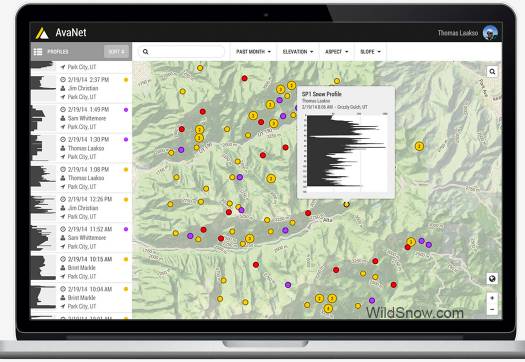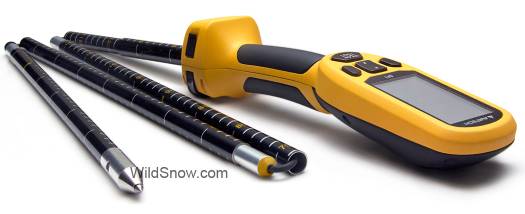Avatech launched their PR today with a revamped website. The company claims their hardware and software will take the tedium out of snowpit data recording — as well as making a major advance in avalanche safety.
The Avatech SP1 densitometer/probe links up via Bluetooth with a smartphone app that in turn works with a cloud database of snow profiles and observations. Goal is a massive and current store of crowd-sourced data, available to any skier in any area where the system is in use and a network is available (cell or wifi.) Apparently, the probe senses pressure as you push it down into the snowpack, thus recording the relative hardness of different layers (it’s tempting to use the word “density” instead of hardness, but a substance can be dense and still soft, so hardness it is, or perhaps the truly technical term is “compressive strength”). It appears that profiles done with the probe easily match or even exceed the accuracy of profiles done on a snowpit wall.
Sound like science fiction? Avatech is real, and probably a good example of how the “second machine age” is radically changing nearly any aspect of our lives. Indeed, if this system works the way it’s presented backcountry skiing will never be the same again. Our sport may become radically safer, but also more complex and dependent on yet another electronic device.
Avatech is nothing new in basic concept in that it goes back to the idea of snow profiles being predictive enough to keep you alive. Snow pits do have their uses, but for much of backcountry skiing have fallen out of favor as a primary predictor. This is due in part to the problem of “spacial variability,” a big-phrase that means snowpits tend to be different depending on where they are dug — sometimes so different as to render them meaningless.
Thus, the kernel of the Avatech idea is to quickly sample so much snow that the problem of spacial variability is obviated. Will that work in real life? Or will the variable data become concentrated into one averaged and subsequently meaningless hodge that looks good on your smartphone screen but tells you nothing? From what I’ve seen the SP1 may indeed take the place of tedious snow pit profiles, but does nothing to replace the basic shovel shear test or slide block. Those methods will have to continue for determining the actual strength of bonding between snow layers. Where Avatech will help is when weak a layer is discovered, information can be shared across the network so any user can quickly probe her vicinity and see if the same weak layer exists. As those additional profiles are created, they too go into the database. A powerful network effect will hopefully be the result. (For the system to work to full effect, a cell or wifi network must be available.)

Avatech will provide cloud based data that’s available on website or app, and they also have a nice snow data recording app that integrates.
Real life consumer testing needs to commence, but my hopes are high. Now I know why we installed satellite wifi up at WildSnow Field HQ.
Press release, edited and condensed:
September 16, 2014 (Park City, Utah) — AvaTech, a new technology company focused on developing breakthrough, proactive snow safety solutions, will unveil its first products, the SP1 and the AvaNet™ cloud platform, during the International Snow Science Workshop later this month. Snow professionals can pre-order from AvaTech at www.avatech.com now.
AvaTech’s SP1 device reads snowpack structure, slope angle and aspect in seconds and then geo-tags the data, and uploads it real-time onto the AvaNet platform. AvaNet will dramatically increase the amount of data snow professionals can share and analyze, providing a unique geo-spatial database of crowd-sourced snowpack observations. Snow professionals will be able to gather more information and make better decisions with consistent data powered by this proprietary technology developed while at the Massachusetts Institute of Technology. Finally, professionals will also be able to rapidly upload their own manual snowpack observations with AvaTech’s Snowpit Editor, which features geo-tagging, photo upload and multiple forms of data visualization.
The SP1 features rugged construction with a collapsible 150 centimeter probe that folds easily into your backpack.”
WildSnow.com publisher emeritus and founder Lou (Louis Dawson) has a 50+ years career in climbing, backcountry skiing and ski mountaineering. He was the first person in history to ski down all 54 Colorado 14,000-foot peaks, has authored numerous books about about backcountry skiing, and has skied from the summit of Denali in Alaska, North America’s highest mountain.

